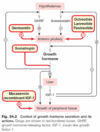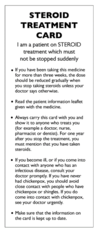Hypothalamic-Pituitary- Adrenal Axis Flashcards
(40 cards)
What are the six Anterior Pituitary hormones?
- ACTH: Adrenocorticotropic Hormone
- FSH: Follicle Stimulating Hormone
- TSH: Thyroid Stimulating Hormone
- PRL: Prolactin
- GH: Growth Hormone
- LH: Luteinizing hormone
What are the two Posterior Pituitary Hormones?
- production
- transport
- store
- ADH: Antidiuretic Hormone
- Oxytocin
- these are synthesised in neurones of the hypothalamus then converted to their active form in the posterior pituitary gland
- supraoptic nuclei
- periventricular nucleus
- inactive forms are transported from the nuclei along the hypothalamico-neurohypophyseal tract
- then stored in the posterior pituitary
Give an overview of Growth Hormone (GH)
- production
- control
- action/effect
- synthesised in the somatotroph cells of the anterior pituitary gland
- secretion is controlled by the hypothalamus
- GHRH (somatotropin) stimulates its secretion
- Growth hormone-releasing hormone
- has a greater role than GHRIH
- stimulated by decreased COH and fatty acids and increased amino acids
- GHRIH (somatostatin) inhibits is release
- Growth hormone-releasing Inhibiting hormone
- GHRH (somatotropin) stimulates its secretion
- acts via 2nd messenger produced in the liver in some tissues
- Insulin-like growth factor 1 and 2
- Primary effects: promote growth in adolescence by increasing protein synthesis and collagen deposition
- foetal growth is also dependent

Give an overview of Oxytocin
- production
- control
- action/effect
- works via IP3 to cause contraction of the smooth muscle of the genital tract and breast
- production increases during pregnancy
- a parallel increase in oxytocin activity is also seen
- secretion of oxytocin is achieved by stimulation of the genitals and nipples
- most important at parturition and lactation
- there is a delay between the start of suckling and milk let down
- Oxytocin is not necessary for the initiation of normal labour
- it can be administered to induce labour

Describe the cycle that leads to oxytocin release
- nipple stimulation
- stimulation of the cervix and vagina

Give an overview of prolactin
- release/ secretion
- control
- action
- secreted by lactotroph (mammotroph) cells in the anterior pituitary gland
- these cells increase during pregnancy and
- prolactin conc. increases during parturition initiating lactation
- secreted in both males and females
- secretion is controlled by
- Prolactin Inhibiting factor = DA
- TRH stimulates prolactin release
- secretion is stimulated by
- mild stress
- nipple stimulation
- coitus
- Action
- contain milk production in females
- maintenance of lactation depends on suckling
- prolactin with other hormones causes proliferation and differentiation of mammary tissue during pregnancy
- inhibits gonadotrophin release and/or response of the hormones to these trophic hormone (ovulation doesn’t occur during breastfeeding)

What are the actions of Prolactin?
(4)
- increase during pregnancy under the influence of oestrogen and progesterone to facilitate lobluloalveolar development of the breast
- causing milk secretion from the breast after oestrogen and progesterone priming
- inhibits GnRH secretion and antagonizes the action of gonadotropins in the ovaries, inhibiting ovulation
- hyperprolactinaemia in men is associated with impotence and hupogonadism
Give an overview of ADH
- release
- stimulation
- action/ receptors
- The hypothalamic nuclei that control fluid balance lie close to the nuclei that synthesise and secrete ADH.
- Stimuli for ADH release
- increased in plasma osmolarity (sensation of thirst)
- hypovolaemia - through stretch receptors in the CVS or angiotensin release
- ADH (vasopressin) receptors are all GPCRs
- V1A and V1B
- coupled to phospholipase C/ inositol triphosphate system
- oxytocin receptors also have GPCRs that are similar to ADH, therefore, ADH acts as a mild agonist at oxytocin receptors
- V2
- these stimulate AC which mediates the main response of ADH in the kidney on the basolateral membrane of the distal tubule and collecting duct
- increases the rate of insertion of aquaporins in the collecting duct in the kidneys
- V1A and V1B
Give an overview of the control of ADH
-
NSAIDs and carbamazepine increase vasopressin effects (Na+ retention)
- Aldosterone (mineralocorticoid) also causes water to be reabsorbed along with sodium.
- Lithium, colchicine and vinca alkaloids decrease vasopressin effects (Na+ excretion).

What clinical investigations are carried out?
- Presentation - Primary Or Secondary?
- Stimulate secretion? (ACTH) or Suppress secretion? (Dexamethasone)
- TSH & T4
- Cortisol
- LH & FSH
- A prolactin (PRL) test
- Testosterone / “Periods”
- After Biochemical Tests: Imaging (e.g. MRI)
- After Imaging: Visual Field Tests
- Bilateral hemianopsia (due to compression of optic chiasm)
Give an overview of the hypothalamus
- location
- inputs/outputs
- action/effect
- lies on either side of the third ventricle, below the thalamus, between the optic chiasm and the midbrain
- receives inputs from the limbic system and the retina
- contains neurons that are sensitive to changes in hormone levels, electrolytes and temperature
- efferent output to the autonomic nervous system
- has greater homeostasis of physiological systems:
- thirst, hunger, sodium and water balance, temp. regulation
- control of circadian and endocrine function
- formation of anterograde memories (with the limbic system)
- translation of response to emotional stimuli into endocrinological and autonomic responses
- has greater homeostasis of physiological systems:

What are Sellar masses and how do they present?
- a mass found in the sellar region in the brain this is composed of the
- bony sellaturcica
- pituitary gland
- adjacent structures
- present with neurological symptoms
- visual impairment: the most common is bitemporal hemianopsia
- __one or both eyes may be affected to varying degrees
- onset of the visual deficit is usually very gradual –> delayed ophthalmologic consultation
- diplopia
- headache: due to the expansion of the sella
- pituitary apoplexy: sudden haemorrhage into an adenoma –> sudden headaches and diplopia
- Cerebrospinal fluid rhinorrhea - inferior extension of the mass
- Parainaud syndrome: a constellation of neuro-ophthalmologic findings (most often paralysis of upward conjugate gaze),
- visual impairment: the most common is bitemporal hemianopsia
- discovered incidentally through MRI, usually with hormonal abnormalities
- hormone deficiencies are of gonadotropins –> hypogonadism
Go over the causes and prevalence of Sellar Masses
- types of adenomas
- differential
- 90% of cellar asses are pituitary adenomas
- these are benign tumours of the anterior pituitary that are neoplastic
- Prevalence of type of adenomas per 100,000
- All adenomas – 77.6
- Lactotroph adenomas – 44.4
- cause hyperprolactinemia –> hypogonadism in men and women
- Nonfunctioning adenomas – 22.2
- gonadotroph adenomas
- thyrotroph adenomas - may cause hyperthyroidism due to increased TSH
- Somatotroph adenomas – 8.6
- cause acromegaly due in increased GH secretion - the majority are clinically silent
- Corticotroph adenomas – 1.2
- cause Cushings disease, but majority remain clinically silent
- Pituitary hyperplasia may present as a sellar masses and be misdiagnosed as pituitary adenoma
Types of Pituitary hyperplasia
- Lactotroph hyperplasia during pregnancy.
- Thyrotroph and gonadotroph hyperplasia due to longstanding primary hypothyroidism and primary hypogonadism, respectively.
- Somatotroph hyperplasia due to ectopic secretion of growth hormone-releasing hormone, a rare condition.
How are Hypothalamic-pituitary hormones transported?
- Neurosecretory cells release peptidergic hormones (median eminence, hypothalamus) – transported in blood via the pituitary portal system.
- hormones also transport via axons from the Parvicellular neurosecretory cells
- Pituitary stalk & pituitary portal vessels pass down through the dura mater which roofs the pituitary fossa.

Review the Hypothalamic-pituitary-adrenal axis controls
(draw it out)


What type of imaging is this, label key features of the HP axis
- plane and weighting

- MRI scan, coronal plane, T1 weighted

What are the Hormones, Receptors & Enzymes of the Adrenal Cortex
- Adrenal cortex hormone production
- GLUCOCORTICOID
- CORTISOL
- MINERALOCORTICOID
- ALDOSTERONE (renin-angiotensin-aldosterone system)
- SEX STEROIDS
- ANDROGENS
- GLUCOCORTICOID
- Binding proteins:
- 90% cortisol bound to cortisol binding globulin (CBG)
- Receptors:
- Intracellular glucocorticoid and mineralocorticoid receptors (GR and MR)
- Enzymes:
- 11-b-hydroxysteroid dehydrogenase (11- b-HSD)
What are the effects of Glucocorticoids?
- Maintenance of homeostasis during stress
- e.g. haemorrhage, infection, anxiety
- Anti-inflammatory
- Energy balance/metabolism
- increase/ maintain normal [glucose]
- Formation of bone and cartilage
- Regulation of blood pressure
- Cognitive function, memory, conditioning
What are cortisol levels like across a day
- effect on the circadian rhythms
- rise during the early morning
- peak just prior to awakening
- fall during the day
- are low in the evening
- in preparation of sleep
Explain Ultradian Rhythms
- this is spontaneous pulsatile release of glucocorticoids during the day
- varying amplitudes
- amplitude decreases in the circadian trough
- associated with
- noise
- anticipatory stress
- response to an unintended stressor
What are the circulating androgens?
- DHEAS from the adrenal glands
- Androstenedione
- Testosterone
- converted to oestrogen by Aromatase
- Dihydrostesterone converted from testosterone by 5-alpha reductase

Explain the function of the 11-ß-HSD-1/2 enzyme
11-ß-HSD-2
- inactivates cortisol in the kidney, colon, sweat glands
- converts it to cortisone
- this allows aldosterone to bind to the mineralocorticoid receptor as they both have the same affinity
11-ß-HSD-1
- converts cortisone back to cortisol in the
- liver, adipose, CNS
- tissue specificity allows gating of GC access to nuclear receptors and amplification of GC signal in target cells

What is the impact of excess cortisol?
- Cushings syndrome
- weight gain
- central obesity
- hypertension
- Insulin resistance
- Neuropsychiatric problems
- Osteoporosis



